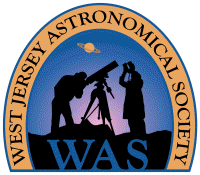| Weather Links |
Mercury 2022 last
sighting May 2 |
Lunar X |
Venus & Jupiter
April 17, 2022
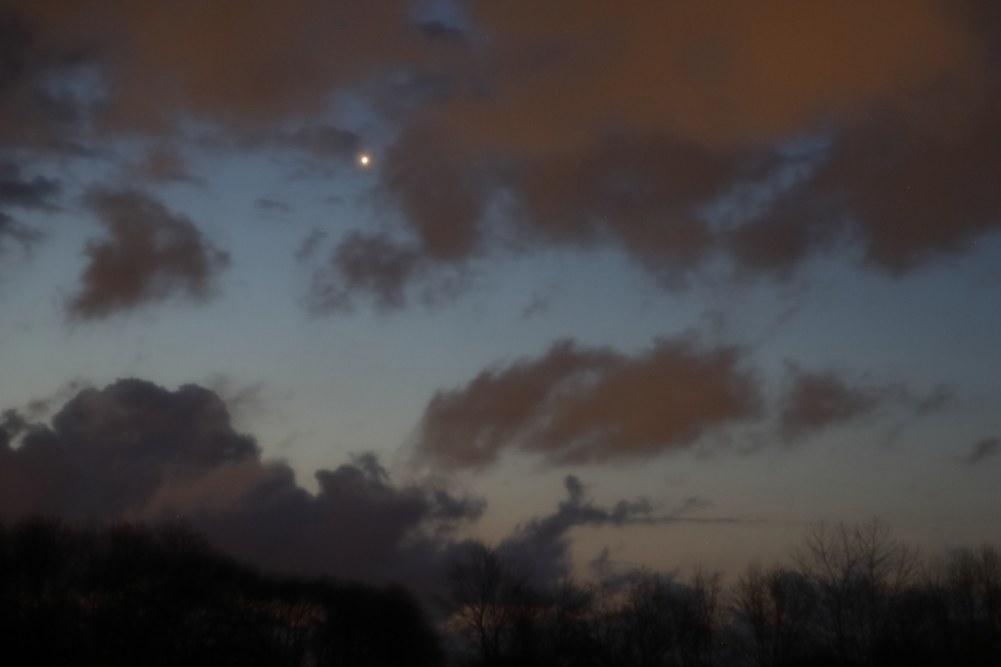
|
On
April 17, 2022, the brilliant planet
Venus (magnitude
-4.2 in
Aquarius) joined the planets Jupiter, Saturn and Mars in a
nearly-straight line low in the east before sunrise (6:19 am
EDT) as observed from Swede Run in
Moorestown, NJ. However, the row of planets was largely obscured
by clouds, which frustratingly would dissipate by time the sky
brightened too much to see them without difficulty. However,
Venus and Jupiter did peek out separately through cloud gaps
while I was there.
This image of Venus was captured at 5:33
am EDT with a Canon EOS RP DSLM camera on a fixed tripod and a
Canon 24 to 105
mm f/4L lens with a Hoya "Diffuser" filter. It was exposed 1.0
second at f/4.5, ISO 1600, auto white balance, adjusted slightly
in Canon's Digital Photo Professional 4 and cropped to 88% of
the original linear dimensions for a field
17.1° wide x 11.5° high. At the time, Venus was at 10.2°
altitude, 19″ apparent diameter and 62% illuminated. |
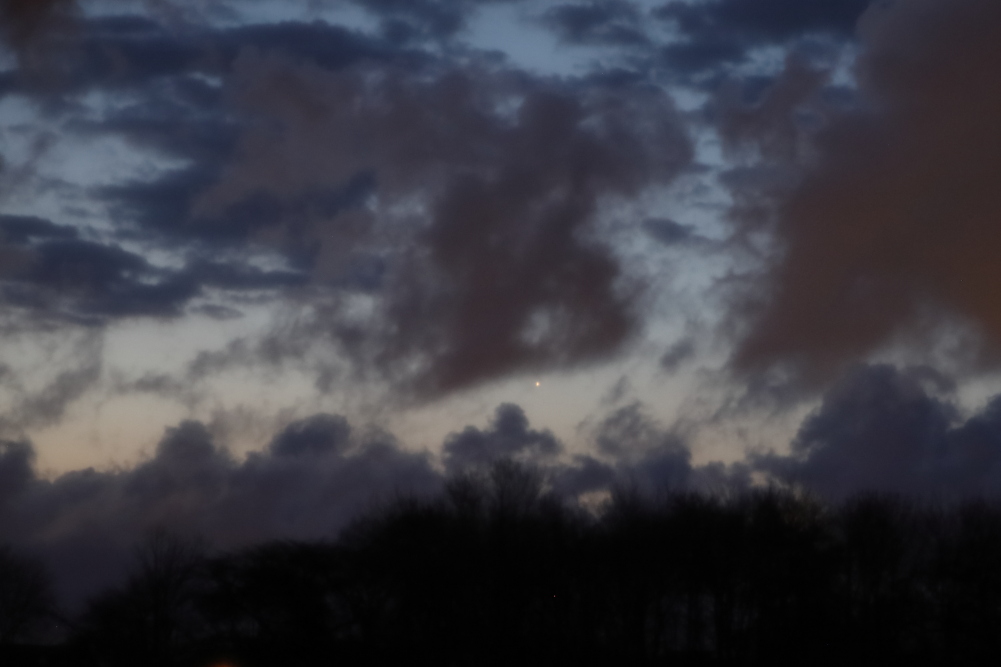
|
On
April 17, 2022, the bright planet
Jupiter (magnitude
-2.1 in
Pisces) joined Venus low in the east before sunrise (6:19 am
EDT) as observed from Swede Run in Moorestown, NJ, appearing
here through a cloud gap.
This image of Jupiter was captured at 5:37
am EDT with a Canon EOS RP DSLM camera on a fixed tripod and a
Canon 24 to 105
mm f/4L lens with a Hoya "Diffuser" filter. It was exposed 0.4
second at f/4.5, ISO 1600, auto white balance, adjusted slightly
in Canon's Digital Photo Professional 4 and cropped to 71% of
the original linear dimensions for a field
13.8° wide x 9.2° high. At the time, Jupiter was at 5.2°
altitude and 34″ apparent equatorial diameter. |
Venus, Saturn & Mars
April 4, 2022
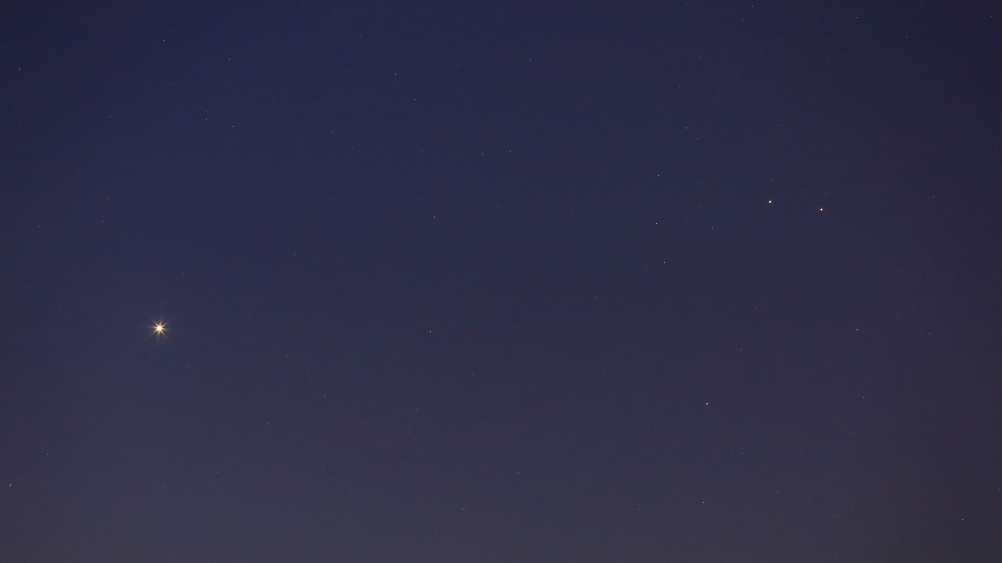
|
On
April 4, 2022, the brilliant planet
Venus (in
Aquarius) was flanked by the closely-paired planets
Saturn
and
Mars
(in
Capricornus) before sunrise as observed from Swede Run in
Moorestown, NJ. Saturn and Mars were just 0.54° apart (about a
moon diameter) while Saturn was 6.5° west of Venus at the time
of this picture. They were all easily visible to unaided eyes in
the morning twilight (the sun would rise at 6:39 am EDT). At
6:00 am,
Jupiter
was spotted at 1.5° altitude, 23.5° east of Venus, then seen
with unaided eyes a couple of minutes later. That was my first
sighting of Jupiter since solar conjunction on March 5, 2022.
Saturn and Mars will be in conjunction at 6 pm EDT on April 4.
On the morning of April 5, Mars will be about a third of a
degree southeast of Saturn vs. half a degree southwest on April
4.
This image of the grouping was captured at 5:39 am EDT with a Canon EOS RP DSLM camera and a Canon
200
mm f/2.8L lens on a fixed tripod. It was exposed 1
second at f/3.5, ISO 3200, daylight white balance. It was adjusted
slightly in Canon's Digital Photo Professional 4 and cropped to
a 16:9 ratio for a field
10.2° wide x 5.7° high. At the time, Venus was at 9.0°
altitude, Saturn 10.2° altitude.
Mouseover for labels.
April 7, 2022: Note the spelling of Deneb Algiedi,
which includes an "i" before the "e." I copied that spelling
from the SkySafari 7 chart. However, going to the information
page, SS7 has "Deneb Algedi" (no extra "i") as a secondary
spelling. Checking a number of other sources, it appears that "Algedi"
is the more common spelling. If I was labeling this picture now
(and previous pictures of this region), I would use
Deneb Algedi. |
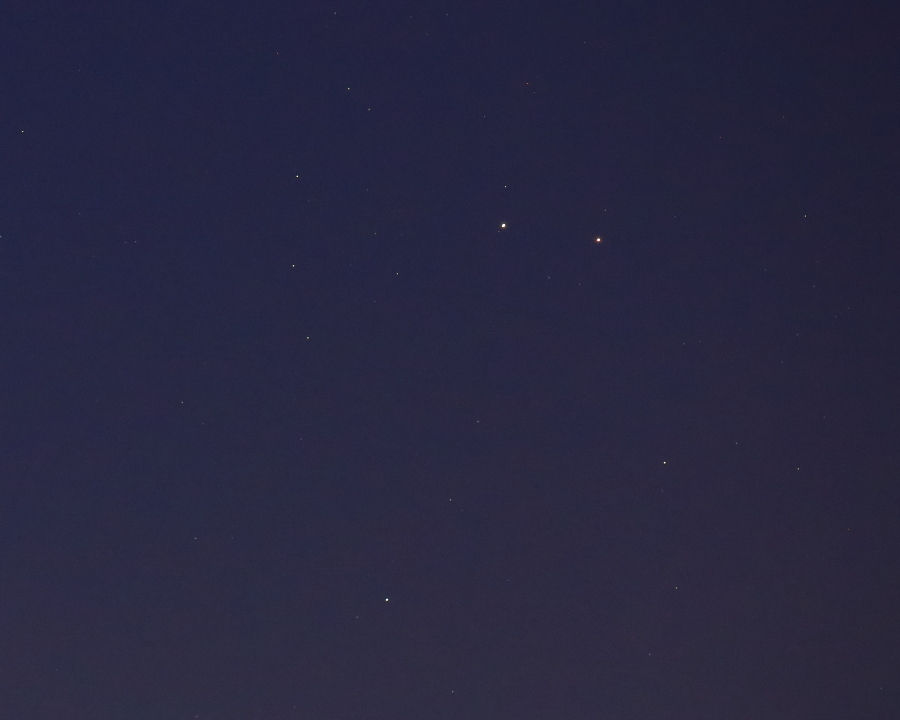
This
is the same original image as above, but cropped further to a field 4.9°
wide x 4.0° high. Mouseover for labels.
Venus, Saturn, Mars and the Crescent Moon
March 28, 2022
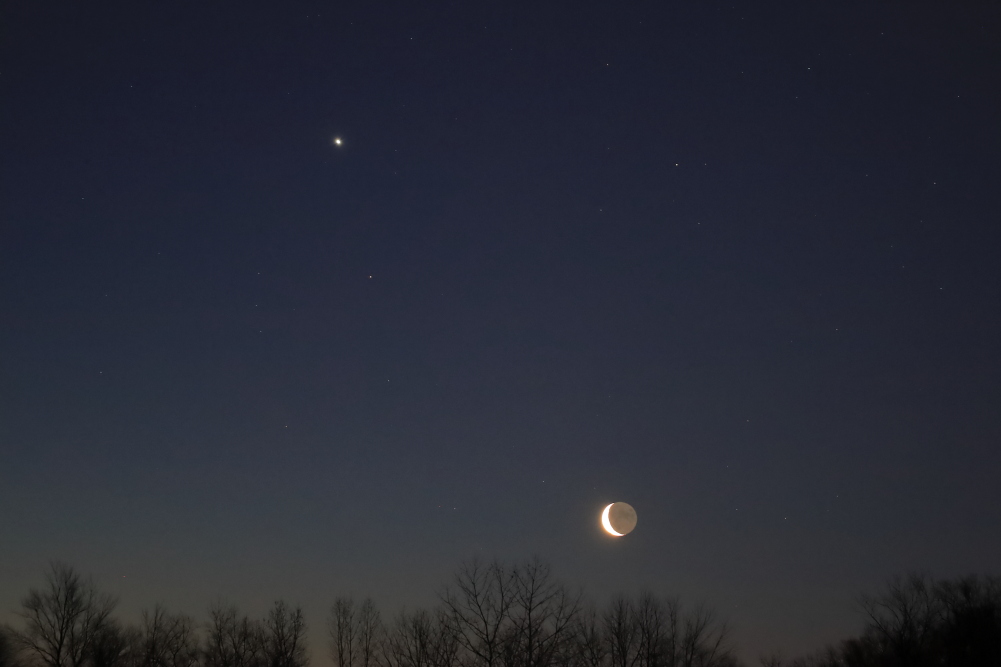
|
On
March 28, 2022, the waning Crescent Moon
joined the planets
Venus,
Saturn
and
Mars
in
Capricornus before sunrise as observed from Swede Run in
Moorestown, NJ, where the sun would rise at 6:50 am. On arrival
at 5:35 am, bright Venus and the Moon were obvious with unaided
eyes, but dimmer Saturn and Mars were easy to see too. All four
of them fit in the 9.1° field of my 8x42 binoculars and they
were still visible when I left at 6:15 am. The 17%
illuminated, 25.7-day-old Moon was 3.8 days before new on April
1, 2022.
This image of the grouping was captured at 5:52 am EDT with a Canon EOS RP DSLM camera and a Canon
100
mm f/2.8L macro lens on a fixed tripod. It was exposed 1/4
second at f/2.8, ISO 4000. It was
lightly adjusted in Canon's Digital Photo Professional 4 and
cropped to 77% of its original linear dimensions for a field
15.7° wide x 10.5° high. At the time, the Moon was at 4.6°
altitude, 7.4° from Venus, which was at 10.3° altitude.
Mouseover for labels. Here's a
Greek
alphabet for reference. Here's a
larger version. |
Young Moon
March 3, 2022

|
The young Crescent Moon
was observed on
March 3, 2022, from the baseball field complex
in Maple Shade, NJ, shortly after sunset at 5:54 pm EST. It was
initially spotted at 6:12 pm with 15x56 binoculars, then seen
immediately afterwards with unaided eyes when it was 29 hr 37
min old, 1.8% illuminated, 8.8° altitude and 15.5° solar
elongation. New Moon was March 2, 2022, at 12:35 pm EST.
This image of the lunar crescent (with some earthshine visible) was
captured at 6:29 pm EST when it was 29 hr 43 min old and 5.8°
altitude. Taken with a Canon EOS RP DSLM camera and a Canon 400
mm f/5.6L telephoto lens on a fixed tripod. It was exposed 1/15
second at f/5.6, ISO 1600, using automatic white balance. It was
lightly adjusted in Canon's Digital Photo Professional and
cropped to 83% of its original linear dimensions for a field
4.3° wide x 2.9° high. |
Omega Centauri
January 27, 2022
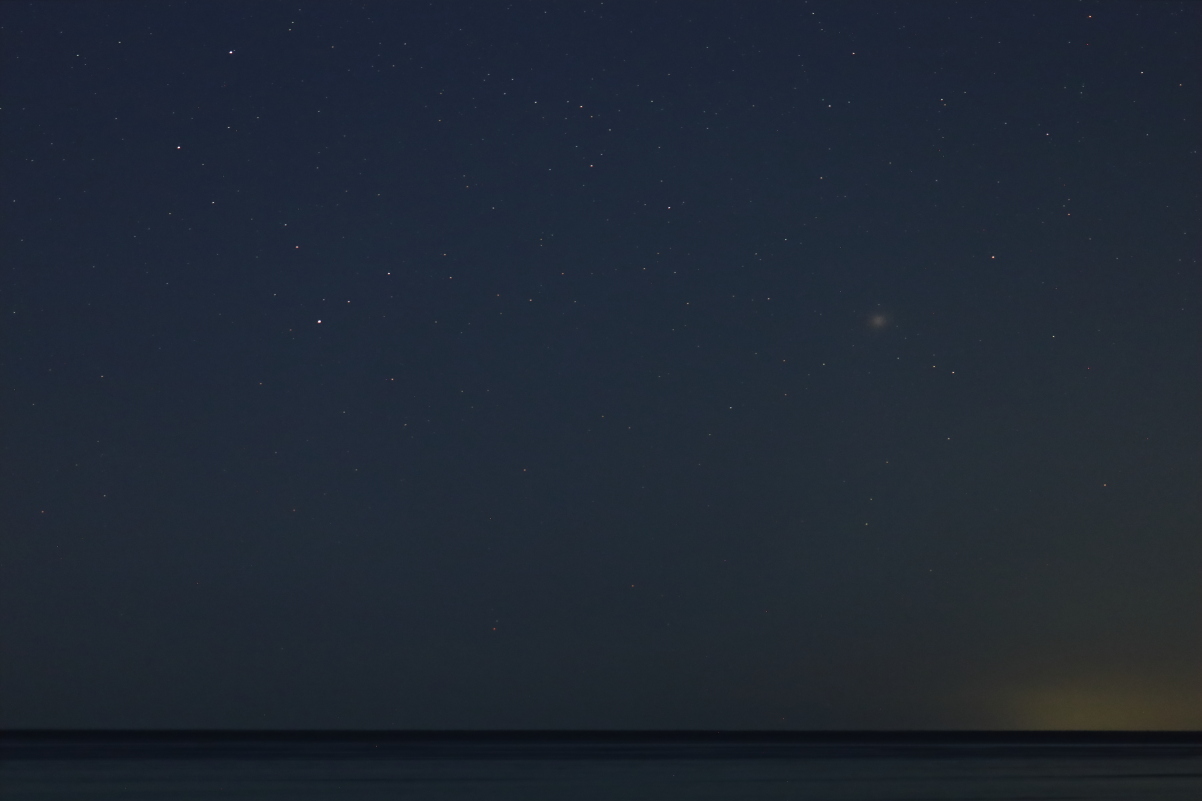
|
For my annual sighting of the great
globular cluster Omega Centauri
(ω Cen, NGC 5139) from New Jersey, I went to East Point along
the north shore of the Delaware Bay on
January 27, 2022, despite a 29% illuminated,
waning crescent moon near the head of Scorpius. The weather was
clear and cold, 18°F on the water's edge at East Point, but as
low as 8°F in the forest north of Cumberland Pond on the way home. I
initially spotted
Omega with 15x56 binoculars at 4:18 am EST, then examined it
with a 115 mm apo spotting scope at 30 to 70x. At the low
altitude, no stars were resolved, even at 70x. It was not
visible to unaided eyes. I went back to East Point on
February 6, 2022, and with a very clear sky
along the southern horizon and no moon, I was able to see all of my
finder stars shown in the picture below with unaided eyes, but
not Omega itself. However, it was easy in 15x56 binoculars, and with
my 115 mm spotting scope at 70x, Omega looked granular rather
than the usual plain haze.
This image was captured on January 27 at 5:03 am EST, one minute
after meridian transit when Omega was at 3.5° apparent altitude and
180.3° azimuth, using a Canon EOS RP DSLM camera and a Canon 200
mm f/2.8L telephoto lens on a fixed tripod. It was exposed 4
seconds at f/2.8, ISO 3200 and 3600K white balance. Virtually no
processing was applied (a slight increase in contrast) and it's
uncropped for a field 10.3° wide x 6.9° high. The darker band at
the bottom is the Delaware Bay, the glow at the right edge of
the sea horizon is from Lewes on the coast of Delaware. Mouseover for
labels.
While there, I also did a little casual observing with the
15x56s, spotting galaxies M51, M81+82, M65+66, M104, planetary
nebula M57, and globular cluster M4 (weaker than
ω Cen despite its greater altitude, about 13°, but closer to the
moon). With the 115 mm spotting scope, I detected comet
C/2019 L3 (ATLAS) in Gemini, by then, low in the northwest. As I
neared home around 7 am, I was looking out the car window for
Venus above the treetops, but didn't spot it until I stopped at
Swede Run in Moorestown, NJ. It was much higher than I expected,
17° at 7 am. Once I was looking in the right direction, Venus
was bright and obvious in morning twilight, now 11% illuminated
and brilliant at
magnitude -4.6. |
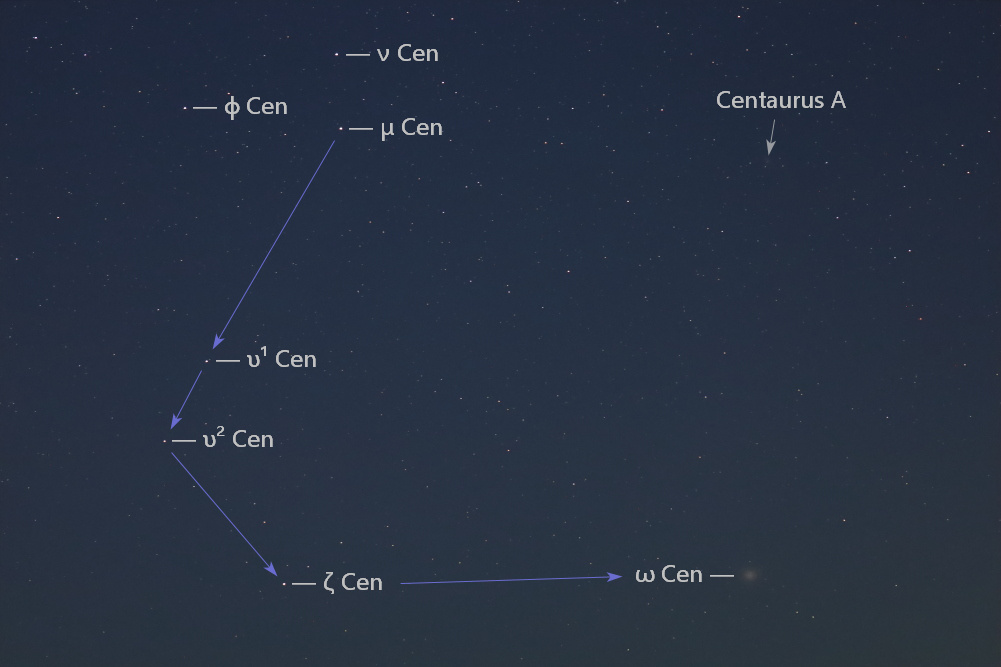
|
This is a separate image captured at 4:58 am EST
on
January 27, 2022,
three minutes before meridian transit when Omega Centauri
was at 3.5° apparent altitude and
179.4° azimuth, but this time, raising the view slightly to
include the peculiar galaxy,
Centaurus A (NGC 5128), about 4.5° north
of (above)
ω Cen. It was taken with the same equipment as the
previous picture, but exposed 4
seconds at f/2.8, ISO 4000 and 3600K white balance. Virtually no
processing was applied (a slight increase in contrast and a
little vignette brightening). The primary image is
uncropped for a field 10.3° wide x 6.9° high, but on
mouseover, the swap image has been cropped to 38% of the
original linear dimensions for a field 4.0° wide x 2.6° high,
providing a slightly better view of Centaurus A. The blue
arrowed lines show the path I follow to find Omega. Starting at
the triangle of magnitude 3.x Phi, Nu and Mu Centauri, I slide
down to Upsilon 1 & 2 Centauri (nominally magnitude 4), then
down to Zeta Centauri, and finally, right to Omega. At magnitude
2.5, Zeta is the brightest of the group, but atmospheric
extinction at the very low altitude belies its brightness. |
Venus is Bright Again
January 15, 2022
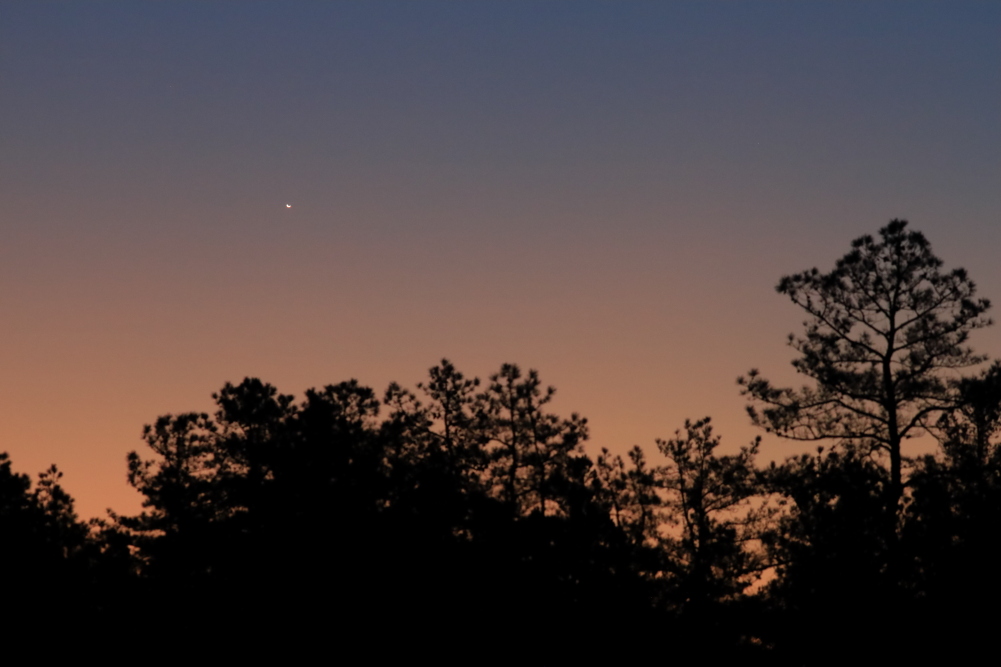
|
The planet Venus
was captured from Wharton State Forest, NJ, on
January 15, 2022, at 6:41 am EST, looking
southeast in the direction of the coming sunrise (at 7:18 am).
Taken with a Canon EOS RP DSLM (digital
single lens
mirrorless) camera and a Canon 400 mm, f/5.6L lens
(on a fixed tripod), uncropped for a field 5.1° wide
x 3.4° high. It's a single raw frame exposed 1/60 second at
f/8, ISO 3200, daylight white balance (but reset to auto white
priority with
Canon's Digital Photo Professional 4). Mouseover for a label.
At the time, Venus was at 4.3° altitude and 11.9° solar
elongation, 61.1″ apparent diameter, 2.0% illuminated and
magnitude -4.2, about 6½ days after inferior
conjunction on January 8 at 7:48 pm EST. It was initially spotted
in the upper tree branches at 6:32 am, 2.7° altitude, with 8x42 binoculars,
then seen immediately with unaided eyes. It was last glimpsed
with unaided eyes at 7:20 am and with the 8x42s at 7:30 am.
The crescent shape was readily visible with the 8x42s.
By 7:40 am, as I packed up and the bright sun was emerging from
the trees, I could no longer locate Venus with the binoculars as
I didn't have a suitable sun-blocking device available.
Around 7 am, I took a look with my 88 mm apo spotting scope at
25 to 60x. The increased magnification provides a better view of
the thickening, but still splendidly-thin crescent. However, it
also brings out the effects of poor seeing at the low altitude,
not to mention remaining turbulence from the front that just
passed through, dropping overnight temperatures into the teens.
My car's thermometer showed 18°F on arrival at WSF, on departure
and when I got back home. At home, my thermometer showed 15°F,
the same as the NWS for Maple Shade, NJ.
Anyway, this was the first time
that I was able to spot Venus with unaided eyes
since December 26, 2021, at East Point, NJ (although the week
following December 26 was consistently cloudy). Indeed, it looked
bright this morning, like the Venus we're accustomed to seeing. |
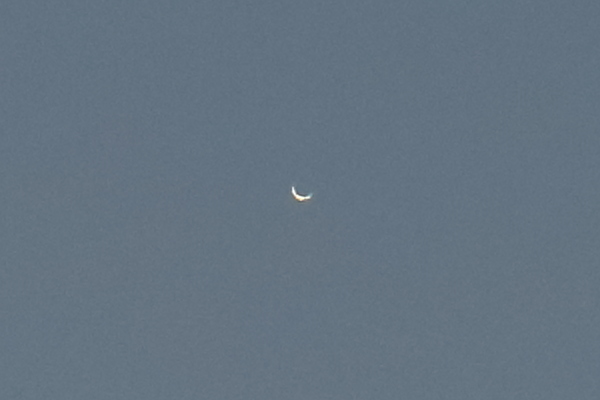
|
This is separate image of Venus taken at 7:11 am EST (half an
hour after the image above) with the same camera and lens setup,
but cropped to 9.6% of the original linear dimensions (less than
a hundredth of the sensor's area) for a field 0.49° wide x 0.33°
high to better show the crescent. It's a single frame exposed
1/1000 second at f/11, ISO 1600 (this is six stops less exposure
than the wide-field shot above due to the greatly increased
sunlight during the additional half-hour that passed). At an apparent diameter of 61.1″ and
400 mm focal length, Venus projected on any surface is
≈0.12 mm diameter. Given the RP's pixel size
of 5.76 μm, the diameter on the sensor would be
≈21 pixels. Ignoring that it's a crescent, the
full disc of Venus would be using only about 350 of the sensor's
26 megapixels! |
Venus, the Morning Star
January 11, 2022
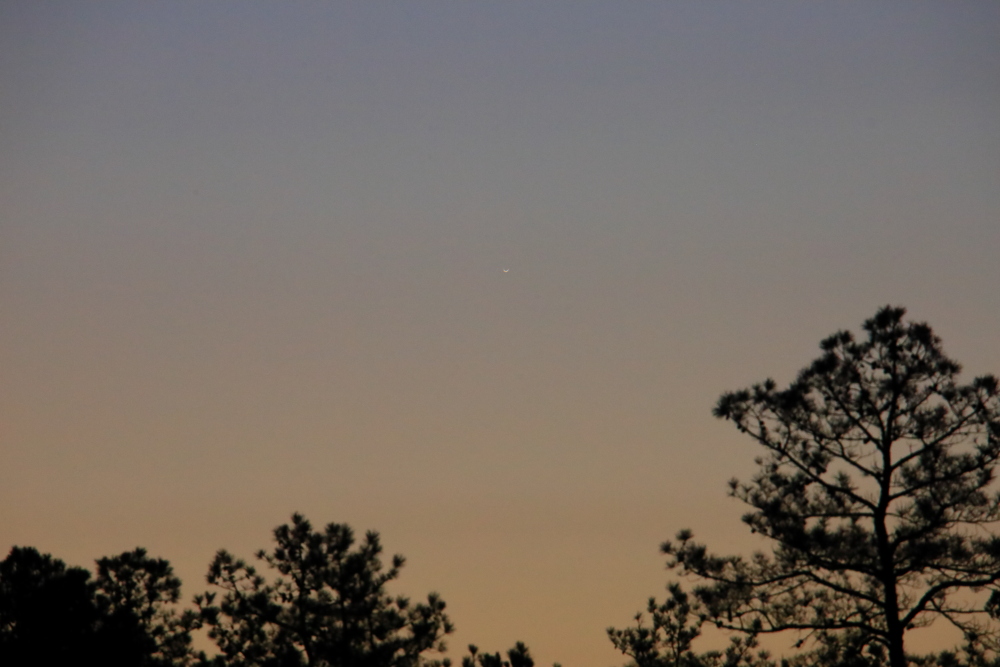
|
The planet Venus
was captured from Wharton State Forest, NJ, on
January 11, 2022, at 7:08 am EST, looking
southeast in the direction of the coming sunrise (at 7:19 am).
Taken with a Canon EOS RP DSLM (digital
single lens
mirrorless) camera and a Tamron 150
to 600 mm, f/5.0-6.3 zoom lens (on a fixed tripod) set to 600 mm focal length, then
cropped to 58% of the original dimensions for a field 2.0° wide
x 1.3° high. It's a single raw frame exposed 1/1250 second at
f/14, ISO 3200, daylight white balance (but reset to auto white
priority with
Canon's Digital Photo Professional 4). Mouseover for a label.
At the time, Venus was at 4.3° altitude, 6.7° above the sun
along a line very nearly perpendicular to the horizon, so the
cusps point essentially straight up. It was 62.6″ apparent
diameter and 0.5% illuminated, 2½ days after inferior
conjunction on January 8 at 7:48 pm EST. However, the crescent
appears thicker in the image than it would visually in a good
telescope later in the day (when it's higher in the sky) due to
atmospheric and photographic effects. On this morning, it was initially spotted
at 7:00 am with 15x56 binoculars and last seen at 7:20 pm when I
packed up. While an easy binocular object at magnitude
-4.1, Venus could not be seen with unaided eyes in the brightening
twilight. |
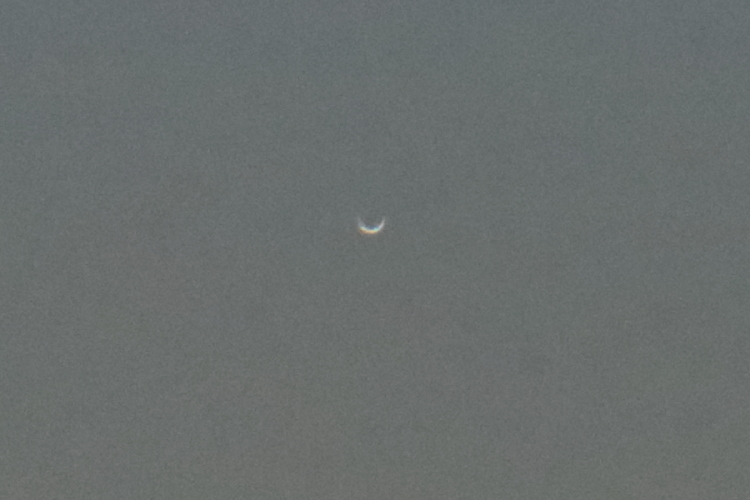
|
This is a heavier crop of the same raw image above, in this
case, 12% of the original linear dimensions for a field about
25′ wide x 17′ high. At an apparent diameter of 62.6″ and 600 mm
focal length, Venus projected on any surface is
≈0.18 mm diameter.
Given the RP's pixel size is 5.76 μm, Venus' diameter would be
≈32 pixels on the
sensor.
Ignoring that it's a crescent, it means
the full disc of Venus would be using only about 800 of the
sensor's 26 megapixels! |
Venus at Inferior Conjunction
January
8, 2022
Venus was at inferior conjunction with the sun at
7:48 pm EST on January 8, 2022, and their separation was just under 5°
(center-to-center). Seeing Venus on the day of inferior conjunction has
been a goal of mine for a long time, but in the past, I’ve been foiled
by a small angular separation between them (e.g., half a degree on June
3, 2020), or poor weather when the separation wasn’t so small.
Astonishingly, on Saturday, January 8, we had a
clear blue sky all day long, so I was finally able to see Venus on the
day of inferior conjunction when its disc reached 62.8” apparent
diameter, and from our perspective, 0.3% illuminated – a delicately thin
crescent.
With the unusually cooperative weather and Venus’
nominal 5°N ecliptic latitude, I was able to spot the thin crescent at
7:19 am EST, two minutes before sunrise, with 15x56 binoculars from
Borton Landing Rd in Moorestown, NJ. It was first sighted in bright
twilight at 2.3° altitude (above the recent addition to the
USS Rancocas) and I followed it until 7:24 am when the orange
limb of the sun peeked above the apparent horizon. At 4.8°
center-to-center separation, I just missed fitting Venus and the solar
limb simultaneously in the 4.5° field of the 15x56s.
At the end of the day on Saturday, I spotted Venus
at 4:44 pm with the 15x56s from the baseball field complex in Maple
Shade, NJ. I lost it in the distant trees at 4:52 pm, sunset. Therefore,
I was able to see Venus at sunrise and sunset of the same day. With the
addition of my sunset spotting on Friday, Jan 7, I saw Venus at both
ends of the night of Jan 7-8 too. Also, Venus was still the “evening
star” (before inferior conjunction) for my morning sighting on Saturday.
In between on Saturday, I observed Venus higher in
a mid-day sky with my 88 mm apo spotting scope at 25 to 60x from the
baseball field complex (using a solar panel on a utility pole to block
the sun). Starting at 1:30 pm when Venus was about 29.5° altitude, I
observed the sublimely thin crescent extending at least halfway around
the circumference, possibly up to 240° depending on the momentary
seeing. There were even brief periods when it looked like the ring
closed around a dusky disc, but I suspect that’s an optical delusion.
Interestingly, at 62.8” diameter and 60x, Venus had
an apparent diameter of about 1° in the scope, nominally twice the
diameter of the moon with unaided eyes. With the 15x56s, the apparent
diameter was a quarter of a degree, half the moon diameter with unaided
eyes. As a result, the crescent was easy to see in the binoculars,
although thickened by atmospheric effects at the rather low altitude
around sunrise and sunset, but thin during mid-day.
Regardless, it was a stunning view in the 88 mm
scope at mid-day, better than any of the numerous images I’ve seen
(e.g., those in the
Spaceweather Photo Gallery). The crescent always looks somewhat
thick in the images. There was at least one image that showed a faint
arc of light closing the gap for full circumference, but there were such
intense artifacts elsewhere along the crescent that one wonders how
realistic it is.
Quadrantid Meteor Shower
Atsion, January 3, 2022
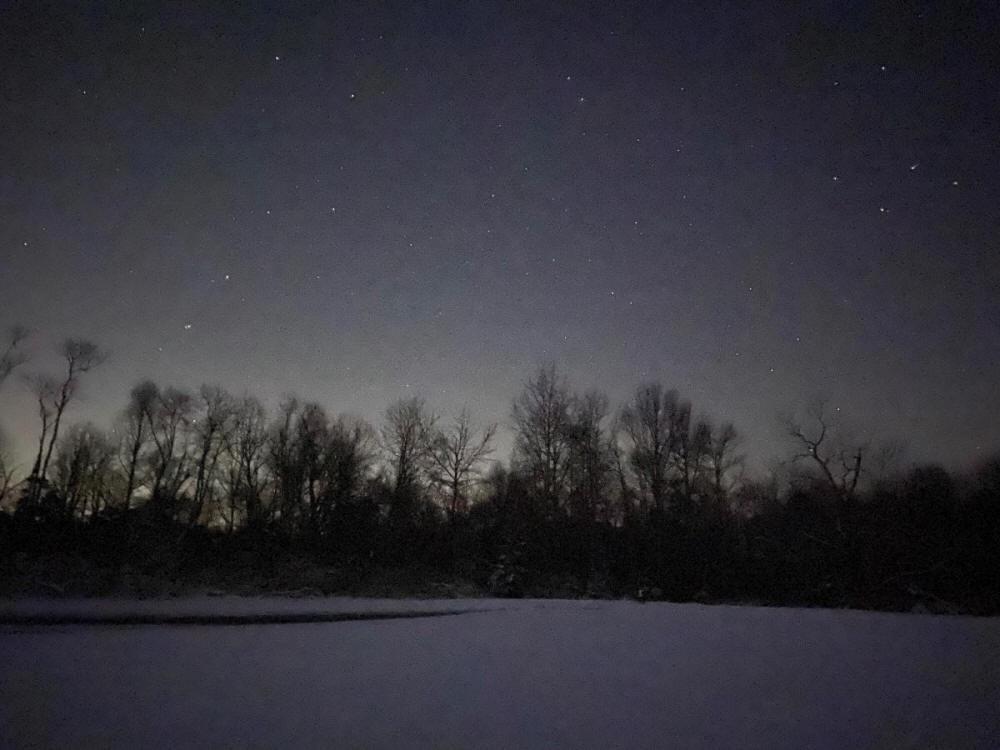
|
Here's a view of Atsion Field in Wharton State Forest, NJ, on
January 3, 2022, at 10:39 pm EST, looking
northeast towards a spot between the Big Dipper in
Ursa Major on the left and
Leo on the right. Taken with a handheld iPhone 11, 4.25 mm
focal length, 1.1 seconds at f/1.8, ISO 8000. There were a
couple of inches of fresh snow on the ground and the temperature
was around 25°F, but the sky was clear. There were a lot of
aircraft passing across this stretch of sky while I was there.
The
Quadrantid meteor shower was predicted to have its narrow
peak around 21 UT (3 pm EST) on January 3, 2022, but it was
cloudy on the morning of January 3, so I decided to try the
evening of January 3. The radiant is nearly circumpolar for
those of us at 40°N latitude, rising around 9 pm. It's north of
the kite-like stick figure of Boötes, between the head of Draco
and Alkaid, the star at the tip of the Big Dipper's handle. It
would be behind the trees near the left edge of the frame.
I started observing at 10:10 pm and continued until 11:50 pm,
most of the time sitting in my lawn chair looking in the
pictured direction. I saw two meteors during that time. The
first was at 11:36 pm, a first magnitude, 10° streak between the
Big Dipper's handle and Leo, heading towards Leo, so it was
probably a Quadrantid. The second second was at 11:42 pm, just
below Alkaid, about second magnitude and a few degrees long, but
heading towards the radiant, so it wasn't a Quadrantid
Not a lot to show for the effort, but as I frequently say, "if
you don't get skunked once in a while, you're not trying hard
enough." |
Click here
for the previous page.
Click here
for an index to all previous SJAstro pages.













